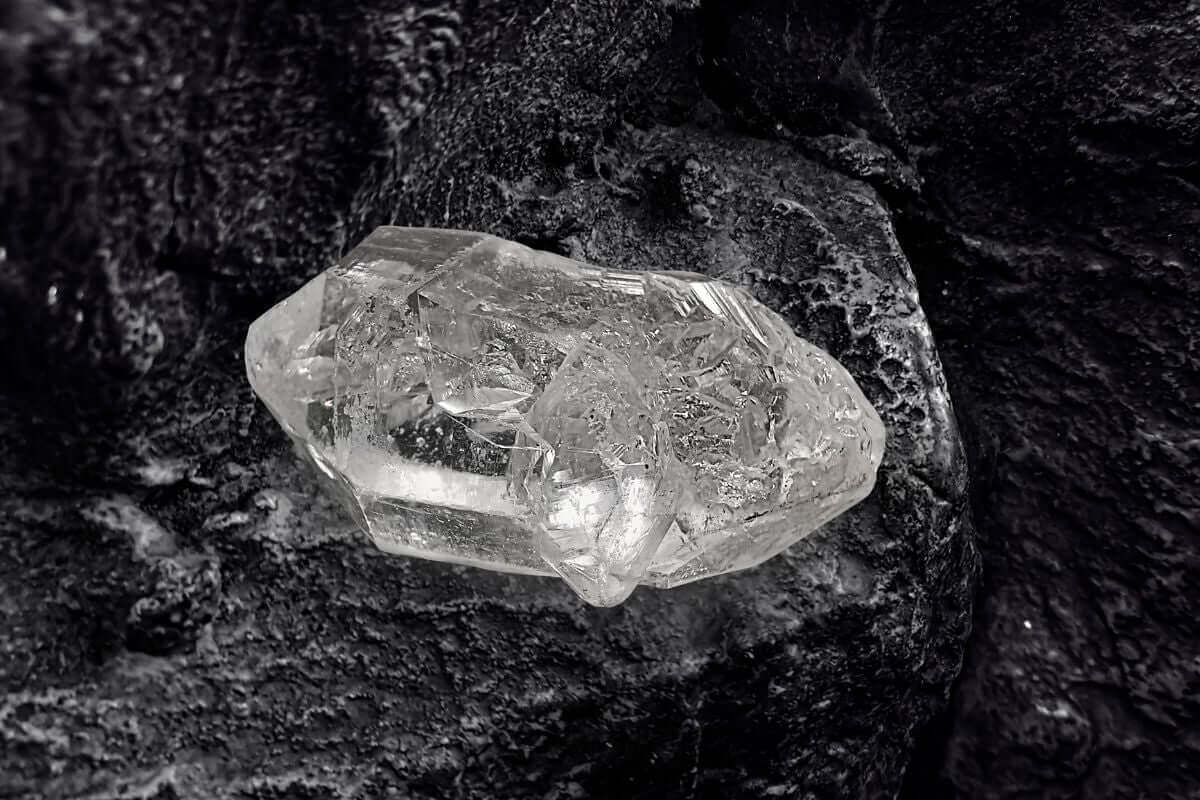- Unlocking the Secrets Behind the Birth of Diamonds
- Powerful Origin of natural Diamonds
- Unstoppable Forces That Forge natural Diamond
- How Mantle Plumes Sculpt the Earth and Form Diamonds
- How Subduction Zones Fuel Diamond Formation
- The Birth of Ultra-High Pressure Diamonds
- The Incredible Journey of Natural Diamonds from Earth’s Core to the Surface
- FAQs
How Natural Diamonds are Formed deep within the Earth over billions of years. Under extreme heat & pressure, volcanic eruptions trigger the formation of carbon crystals, which transform into diamonds. This crystalline form of pure carbon forms by a reaction involving high heat & pressure, resulting in creation of natural diamonds.
Understanding how natural diamond formed reveal incredible journey this gems take from deep underground toward surface, where it eventually discovered & treasured.
“Throughout history, diamonds have held deep cultural and emotional significance — it’s no surprise that they are also celebrated as the birthstone for April, as noted by the American Gem Society.”
Natural Diamonds formed unique treasures of planet, its unmatched beauty, brilliance, & durability. We are amazed to see how amazing this gemstones are formed deep within the Earth.
The journey of a natural diamond its formation to discovery is really a fascinating process that unfolds over billions of years, shaped through intense heat, pressure, and geological occurrence. Let’s delve into the top 8 processes responsible for the creation of natural diamonds.
Unlocking the Secrets Behind the Birth of Diamonds
Process how Natural Diamonds are formed begins with one of Earth’s most abundant elements—carbon. The journey of crystalline diamond structure isn’t chemical transformation & geological marvel to requiring highly specific & extreme conditions. The detail role of carbon & how its composition impacts of natural diamond formation.
Powerful Origin of natural Diamonds
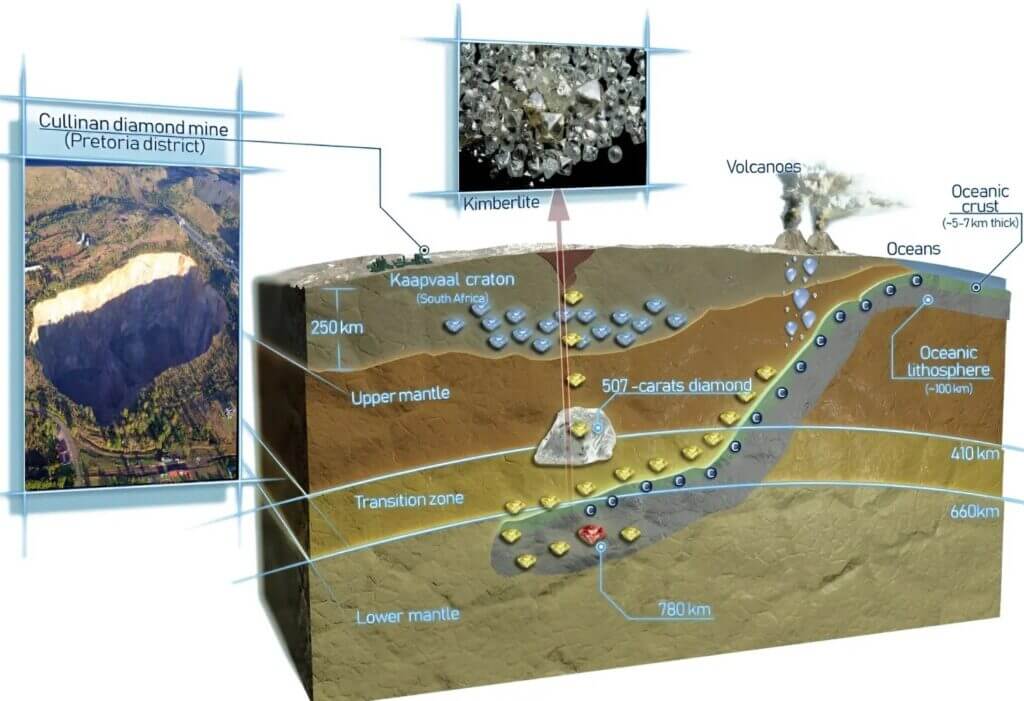
Natural diamonds formed primarily that derived from these major sources:
Primordial Carbon from the Earth’s Mantle:
The natural diamonds formed from part of Earth’s mantle its formation approximately 4.5 billion years ago. Carbon is elemental, it exists in its pure, uncombined form as simple compounds that have been stable under mantle conditions.
2: Subducted Organic Carbon:
The source of carbon comes from organic materials ancient plant & microbial life subducted into Earth’s mantle tectonic processes. Over millions of years, these materials undergo chemical transformation under immense heat and pressure, contributing to the formation of diamonds.
3: Carbon’s Crystalline Transformation:
For carbon that transform into a diamond, it crystallize in a specific arrangement. This process involves:
- Extreme Conditions: Diamond formed deep in the Earth’s mantle at the depths of 150-200 kilometers, temperatures range from 900°C to 1,300°C, and pressures exceed 5 GA (gigapascals). These conditions cause carbon atoms to rearranged into a cubic crystalline lattice.
- Covalent Bonding: It is unparalleled hardness & resilience lies in covalent bonding of its carbon atoms. Each carbon atom bond with four neighboring carbon atoms in tetrahedral structure & create a tightly packed, three-dimensional structure
Purity and Inclusions:
Natural Diamonds formed near-purity, they often contain minute impurities or inclusions that provide critical insights into their origins:
- Nitrogen’s: Common impurity in the natural diamond, nitrogen atoms are substitute for carbon within lattice. Its presence affect the diamond’s color, range from yellow to orange hues.
- Mineral Inclusions: It tell olivine, garnet, pyroxene, encapsulated diamond formation it provide clues for such conditions & environment in the Earth’s mantle.
- Carbon Isotopes: Ratio of carbon isotope (C12 & C13) in diamond offer evidence of its carbon source. The organic origin diamond tend toward distinctive isotopic structure like compared toward primordial mantle carbon.
The Role of Volatiles:
Volatiles like hydrogen, methane (CH4), & carbon dioxide (CO2) play role in influencing the carbon’s journey toward diamond crystallization:
- Catalysis: Volatiles act like catalysts, that lowering the energy barriers for diamond formation.
- Mediators: Substances that facilitate migration and concentration of carbon in diamond-stable regions of the mantle.
Importance of Carbon Purity
Purity of the carbon source affects diamond’s quality. Diamond is fewer inclusions & impurities exhibit greater clarity and brilliance, which enhances their value as gemstones. The diamonds with significant impurities often used for industrial applications, like cutting and drilling tools.
The formation of how natural diamonds are formed relied on carbon’s & its ability to undergo extreme transformation under specific conditions. Either sourced from primordial mantle like ancient organic materials, carbon is subjected toward intense heat& pressure, leading to its crystalline arrangement as diamond. Each diamond are telling a story of its unique journey—from going to the depths of the Earth, through tectonic processes, toward its eventual discovery. It profound transformation testament dynamic & intricate processes of our planet.
Unstoppable Forces That Forge natural Diamond
The Natural Diamonds formed in Earth’s history, it requiring specific or extreme environmental conditions. Among this, high-pressure & high-temperature (HPHT) conditions are pivotal. This parameter that occur deep in the Earth’s mantle that are crucial for transforming carbon into its diamond form. Let’s delve into how HPHT conditions facilitate the formation of this remarkable gems.
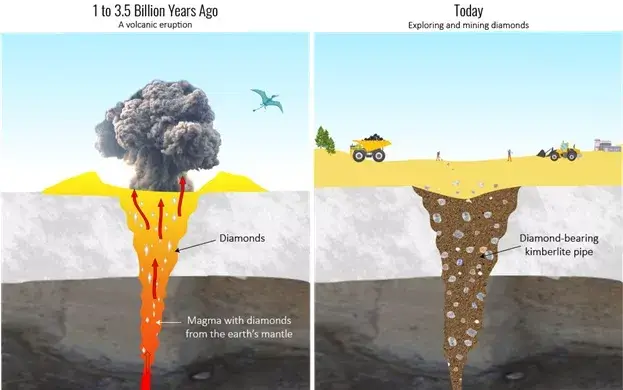
The Geological Setting for HPHT Conditions:
Natural diamonds are form within region of the Earth’s mantle that known as the “diamond stability zone.”
- Location:
- It must be Found at the deep approximately 150-200 kilometers below the Earth’s surface.
- This Superdeep diamonds form at depths exceeding 600 kilometers
- Pressure:
- Condition that exceed 5 GPa to approximately 725,000 pounds (psi) is noted.
- Temperature:
- Its Range from 900°C to 1,300°C temperatures that’s high and enough for carbon atoms to reorganized into diamond crystalline structure.
This extreme condition occurs naturally in tectonic activity region, as sub-duction zones, or mantle plume, and areas of deep volcanic processes.
The Role of Pressure in Diamond Formation
- The High pressure is fundamental in over all energetic barriers that prevent carbon atoms forming a diamond structure under its ordinary condition.
- Atomic Rearrangement: Under high pressure, carbon atom forced closer together, that destabilizing make weaker carbon configurations like graphite.
- The compression enable to make formation of diamond cubic lattice structure, each carbon atom is tetrahedrally bonded to four other atom.
- Metastability: Bonding arrangement of natural diamond graphite thermo-dynamically stable at surface pressures.
The Importance of Temperature in the HPHT Environment:
High temperature are play a important role by enabling the formation of carbon atoms.
- Energy Supply:
- Heat provides necessary energy to break and re-form chemical bonds, and allowing carbon atoms to transition and from disorganized states to ordered diamond lattice.
- Mantle Convection:
- The heat generated by the mantle convection & decay of radioactive element provides thermal energy for diamond stability.
- Crystal Growth:
- Sustained the high temperature allow carbon atoms to migrate & bond at surfaces of growing diamond crystals, leading to its characteristic that octahedral shape of natural diamonds.
4: The HPHT Window: A Narrow Pathway:
Diamonds are formed within a specific “HPHT window,” that defined by its precise pressure and temperature limits:
- This condition outside the range from the formation of diamond, allotropes, as graphite or amorphous carbon.
- Geological variations—that shifts in mantle dynamics—can temporarily disrupt diamond growth, & make the process rare and long-lasting.
5: Natural Phenomena Facilitating HPHT Conditions:
This are process that contribute to establishing this HPHT environment,
- Tectonic Subduction:
- Carbon that contained sediments of rocks pushed deep into the mantle zones, exposing into intense pressure and heat.
- Mantle Plumes:
- Upwellings of hot, the buoyant rock from deep in the mantle create zones of high pressure and temperature where diamonds can crystallize.
- Kimberlite and Lamproite Magmatism:
- The volcanic processes isn’t HPHT conditions its conduits to transport diamonds to Earth’s surface.
6: Evidence of HPHT Conditions in Natural Diamonds:
- Natural diamonds provide direct evidence of the extreme conditions under which they formed:
- This rare diamonds contain exotic inclusions, like bridgmanite, a high-pressure mineral found only deep within the mantle
- Inclusions: Minerals like garnet, olivine, and pyroxene are often trapped within diamonds, indicating their high-pressure origins.
- Carbon Isotopic Composition: The isotopic variation in carbon the diamonds can point to the specific geological setting of there formation.
Superdeep Diamonds:
This rare diamonds contain exotic inclusions, like bridgmanite, a high-pressure mineral found only deep within the mantle. High-pressure and high-temperature conditions are the cornerstone of natural diamond formation. The immense forces and temperatures deep within the Earth’s mantle enable carbon to crystallize into its hardest and most stunning form. By understanding HPHT processes, we isn’t gain insight into creation of this remarkable gems & deepen our appreciation for extraordinary natural phenomena shaping our planet over billions of years. The rarity & endurance of diamonds are a direct testament to the relentless and transformative power of the Earth’s interior.
How Mantle Plumes Sculpt the Earth and Form Diamonds
The Natural Diamonds formed is extraordinary geological process deeply tied to dynamic activities within the Earth’s mantle. Among this activities, mantle plumes and geological movements like plate tectonics play critical roles in creating those conditions necessary for diamond formation and its eventual transport to the Earth’s surface. This article explores how mantle plumes and geological movements contribute to the formation and accessibility of natural diamonds.
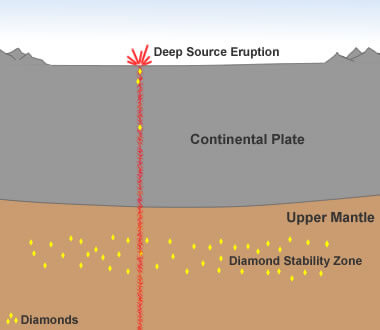
Mantle upwelling of diamond
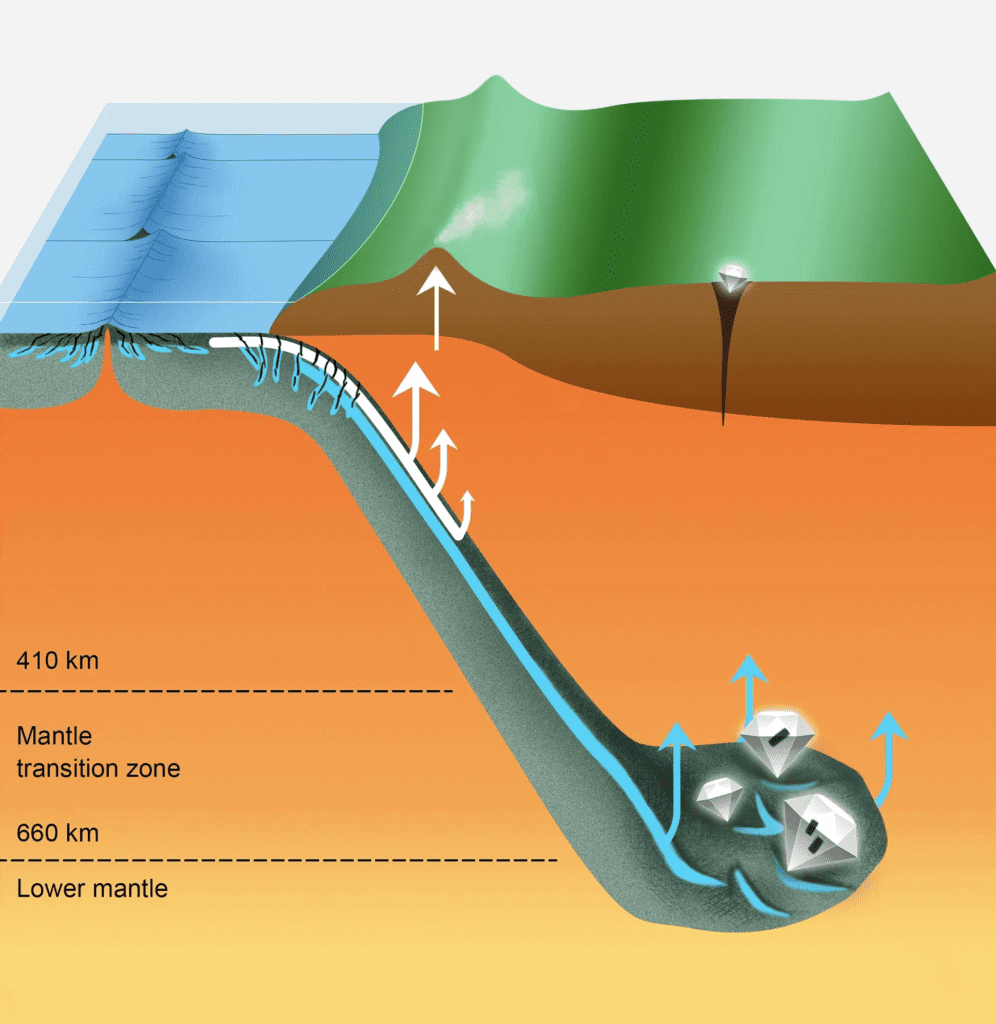
Mantle Upwelling in natural Diamond Creation
Plumes is localized upwelling of hot, that buoyant rock form deep in the Earth’s mantle. This plumes originate near the core-mantle boundary, at depths of 2,900 kilometers. The geodynamic processes provide high-pressure & high-temperature (HPHT) condition crucial for diamond formation.
Key features of mantle plumes:
- Heat Source: The heat from mantle plumes contributes to thermal anomalies within the mantle, driving convection and the partial melting of surrounding rock.
- Localized Upwellings: It is widespread mantle convection, plumes are narrow, that mainly focused streams of hot material that travel upward.
- Link to Hotspots: Plumes are associated with volcanic hotspots, like that beneath Hawaii and Iceland.
Mantle Plumes and HPHT Conditions for Diamond Formation
Natural Diamonds formed deep within the Earth’s mantle in a zone referred to as the “diamond stability field.” Mantle plumes help create and sustain this zone by:
- Generating Heat: The transported heat by mantle plumes that raises temperature of surrounding mantle rock. It increase in temperature that drive carbon-bearing material into diamond stability field (depths of 150-200 km, pressures >5 GPa, and temperatures of 900°C to 1,300°C).
- Providing Stability: Mantle rising current create localized high pressure overlying material, preserving diamonds in crystalline form.
Geological Movements and Diamond Formation
Geological movement like plate tectonics, subduction, & rifting that are crucial for cycling of carbon into mantle and eventual retrieval of diamonds from the depths. Here’s how it interact with mantle plumes to influence diamond formation:
a. Subduction Zones
- Carbon Recycling: At sub-duction zones, organic carbon from sedimentary rocks & carbonate minerals is carried into the mantle.
- Diamond Formation: Sub-ducted carbon experience toward temperature conditions, transforming diamond into stability condition.
b. Rift Zones
Tectonic Spreading: Rift zones—regions where tectonic plates diverge—promote mantle upwelling and volcanic activity, often influenced by mantle plumes. Mantle Access: These zones may expose deep portions of the mantle and can create conditions for diamond stability in localized regions.
c. Mantle Plumes and Kimberlite Volcanism
It is interaction between mantle plumes & geological movements that results in kimberlite or lamproite eruptions, which are the key to transporting diamonds on to the surface.
- Kimberlite Pipes: Kimberlite magmas, that originating from the deep mantle region, use pathway for creating the mantle plum activity . This pipes are the primary sources of diamond mining.
- Rapid Ascent: The speed at which kimberlites ascend prevents diamonds from reverting to graphite under surface pressures
Evidence of Mantle Plume Influence on Diamonds
Scientists use several indicators to link diamond formation and transport to mantle plumes:
- Geochemical Signatures: Diamond often contain inclusion of mantle-derived minerals, like peridotite garnet or eclogitic pyroxene, which associated with plume-related magmas.
- Superdeep Diamonds: Some rare diamond, originating at depth of 600-700 km, it may form near the base of mantle plume & offer evidence of extremely high-pressure origins.
- Hotspot Correlation: Many diamond-rich regions, like southern Africa’s Kaapvaal Craton, align with ancient mantle plume hotspots
Geological Stability and Diamond Preservation
Natural Diamonds formed under mantle plume-influenced conditions require preservation in stable geological settings over millions or billions of years. Cratonic regions, with their ancient and thick lithosphere, serve as the ideal environment for this preservation. Mantle plumes often intersect these cratonic roots, creating conditions conducive to diamond formation and contributing to the accumulation of economically viable deposits.
Mantle plumes and geological movements form the backbone of natural diamond formation and transportation. This dynamic processes create the extreme pressures and temperatures necessary for diamond to crystallize and serve conduits for bringing toward Earth’s surface through volcanic eruption. By understanding mantle plumes and tectonic interactions, we gain deeper appreciation for the long, complex journey of natural diamond from the Earth’s mantle to their glittering presence in our lives.
How Kimberlite & Lamproite Deliver Diamonds to the Surface
Natural Diamonds formed begin deep within the Earth’s mantle under the condition of extreme pressure and temperature. It isn’t enough for diamond to simply form; they must be transported in to the surface for discovered and admired. Its critical transport mechanism occurs volcanic eruption, kimberlite & lamproite magmas. These rare volcanic processes are the primary pathways by which diamonds make its way from the depth of the Earth to the surface.
Kimberlite and lamproite are types of igneous rocks that carriers diamonds from the Earth’s mantle. Both ultramafic high levels of magnesium iron & originate from Earth’s deep mantle.
Kimberlite:
- Most common host rock for diamonds are
- Named after town of Kimberley in South Africa,
- from where it was first identified.
- It Often associate with ancient cratonic region, which are geologically stable areas of Earth’s crust.
Lamproite:
- Are Less common like kimberlite& viable carrier of the diamonds.
- Notable examples include the Argyle diamond deposit in Australia.
- Region of thinner lithospheric roots compared kimberlite
Role in Diamond Transportation
Natural Diamonds formed at depth of 150-200 kilometers in Earth’s mantle. This diamonds to reach the surface without transform back to graphite, with rapid and violent transportation mechanism is required. Kimberlite & lamproite eruptions are perfectly suited for purpose for unique geologic properties:
- Source Depth: Kimberlite and lamproite magmas are originate in the mantle’s diamond stability zone, where diamond form.
- Rapid Ascent: These eruptions ascend through the lithosphere at speeds exceeding 20-30 kilometers per hour, ensuring minimal heat exposure that could destabilize diamond structures.
- Explosive Energy: Both kimberlite & lamproite eruptions highly explosive, propelled volatile-rich magmas (containing carbon dioxide & water). This explosive nature breaks through overlying rock layers, creating a direct conduit to the surface.
Formation of Kimberlite and Lamproite Pipes
The unique geological structures associated eruptions called volcanic pipes. It takes carrot-like shape explosive nature of eruptions.
Kimberlite Pipes:
- Funnel-shaped structures that expand closer to the surface.
- Composed of fragmented mantle rock, magma, and sometimes diamonds.
Lamproite Pipes:
- Tend toward irregular & complex toward variations in magma composition.
- Both of pipes are mined for diamond, with kimberlite pipes that being the most commercially significant.
Geologically Triggers of Kimberlite and Lamproite Eruptions
Several geological processes can trigger these rare eruptions:
- Mantle Plumes: The upwelling of hot mantle material that may generate those condition necessary for kimberlite and lamproite magmas to form erupt.
- Tectonic Activity: Tectonic plate movement create pathways for deep seated magmas to rise.
- Volatile Concentration: High concentration of volatiles like CO2 & H2O reduce magma viscosity, facilitating rapid ascent.
5: Kimberlite & Lamproite Deposit of Evidence
Natural diamonds often carry geological clues about their journey:
- Mineral Inclusion: Tiny fragment of mantle mineral, garnet & olivine, trapped inside diamond, provide insight into its formation of environment.
- Mineral Inclusions: Tiny fragment of mantle minerals, garnet and olivine, trapped inside diamonds, that provide insights into its formation of environment.
- Trace Elements and its Isotope: Kimberlite & lamproite deposit rich in unique geochemical signatures to identify mantle origin.
6: Deposits Linked to Kimberlite and Lamproite
Many of the world’s most significant diamond mines are associated with these volcanic eruptions:
Kimberlite:
- De Beers Mine, South Africa.
- Ekiti and Devaki Mines, Canada.
- Mir Mine, Russia.
Lamproite:
- Argyle Mine, Australia (famous for its pink diamonds).
- Ellendale Mine, Australia.
7: Exploration and Mining
Kimberlite and lamproite pipes have undergone this brief description.
- Geophysical report: Methods like magnetic and gravity surveys help identify underground volcanic pipes.
- Erosion and Preservation: Many ancient kimberlite & lamproite pipes have eroded over time, complicating exploration effort. Kimberlite & lamproite eruptions are indispensable to its journey of natural diamonds, transporting this precious stones from their formation depths to the Earth’s surface. Its rarity, explosive power, & geological uniqueness isn’t make diamond carries into deep Earth. Understanding processes isn’t highlight immense forces that create natural diamonds it underscores its value & rarity of this extraordinary gemstones.
How Subduction Zones Fuel Diamond Formation
Subduction zones, & tectonic plate slides beneath other, & key sites for diamond formation. In this region, carbon-rich materials that subjected toward extreme heat and pressure as they a pushed deep into the Earth’s mantle. Its, materials transform to diamond, resurfacing by volcanic activity & tectonic uplift.
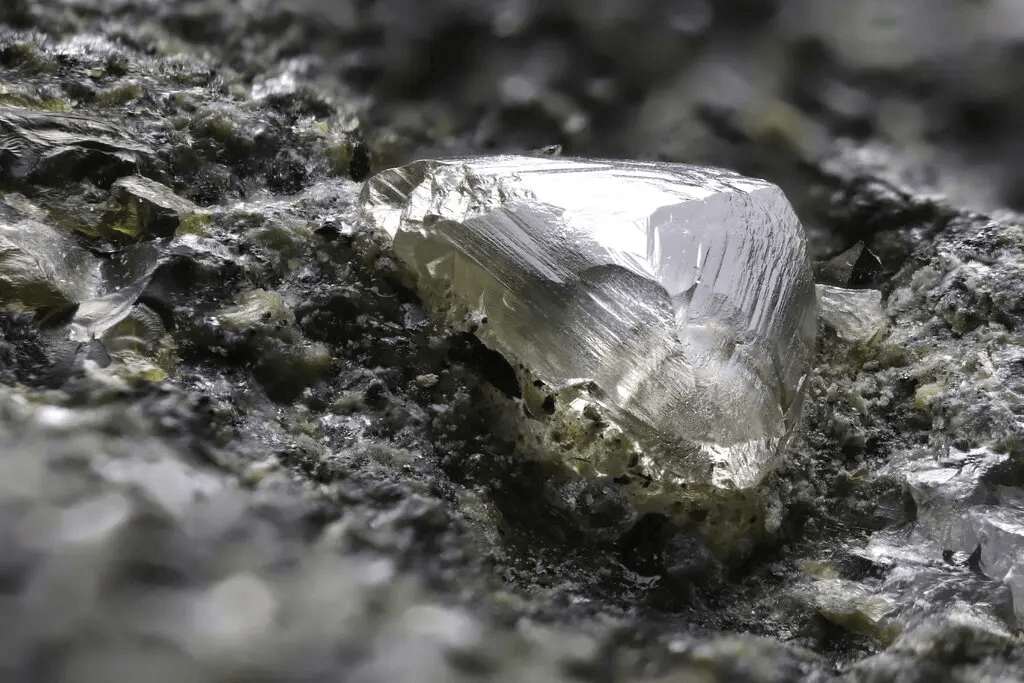
Metamorphic Journey Turns Rocks into Diamonds
It is less common alike mantle derived diamond, some diamonds found through metamorphic processes. The carbon rich rocks experience intense heat & pressure towards tectonic collisions, it recrystallize into diamonds. This process is associated with high-pressure metamorphic rocks found in orogenic belts—mountain ranges formed through plate collisions.
Extraordinary Journey of Deep-Sea Sediment to Diamond
Some natural diamonds that believed to form by the transformation of organic materials that found in deep-sea sediments. Its sediments subducted into mantle, & undergo chemical & physical changes towards immense heat and pressure, resulting in diamond formation. This process emphasizes role of Earth’s carbon cycle in creating this extraordinary gems.
Deep-sea sediment is layer of organic and inorganic material which accumulate on ocean floor over million of years. This sediment primarily consist of:
- Organic carbon source: It derived from remains of marine organisms like plankton, algae, and many other carbon-based life forms.
- Inorganic carbonates source: It originating from shell and skeletal fragments of marine organisms composed of calcium carbonate.
- Clay and silt particles source: It consist of Fine-grained material transported by rivers, wind, & underwater currents.
This sediments settle on ocean floor, forming thick deposit over time. A tectonic processes drive portions of ocean crust and sedimentary layer into subduction zones, carbon-rich content of deep-sea sediments undergoes a transformation ultimately result in the formation of diamond.
How Oceanic Sediments Journey Deep into the Earth’s Mantle to Become Diamonds
The mechanism for deep-sea sediment transformation into diamonds is subduction process where tectonic plate is forced underneath, pushing oceanic crust and sediment deep into Earth’s mantle. This process occurs at the subduction zones:
- Subduction Process phase: A sediment is dragged down with subducting oceanic plate, they subjected toward intense pressures & high temperatures.
- Carbon Transformation phase: The carbon content in sediments, organic carbon or carbonate material, begins to change structurally under extreme mantle condition.
At depths greater the 100 kilometers, the necessary high-pressure and high-temperature (HPHT) environment forces carbon atoms into a denser, more stable crystal structure—diamond.
Conditions That Transform Subducted Sediments Into Precious Diamonds
For diamonds to form via deep-sea sediment transformation, a few crucial conditions must align:
- Adequate Carbon Source:
- Organic carbon from the remnants of marine life and inorganic carbonates provide the foundational carbon material for diamond crystallization.
- High-Pressure Environments source:
- A sediment is subducted to depth of 100-150 kilometers, & pressures in range of 45-60 kilobars facilitate structural realignment of carbon into diamond.
- High Temperatures:
- Subduction-related environments often reach temperatures around 1,000-1,300°C—ideal for carbon atoms to rearrange into their cubic diamond lattice.
- Rapid Preservation:
- For the resulting diamonds to remain stable, they must avoid exposure to slower geological heating processes, which could revert diamonds to graphite.
How They Forge Diamonds Deep Below the Earth’s Surface
This zone act as carbon recycling center. They facilitate the movement of carbon from the surface into the deep mantle:
- Organic carbon and carbonate rocks are taken to extreme depths along with the sinking oceanic plate.
- Intense metamorphism that convert carbon-bearing sediments into diamond.
This phenomena highlight carbon from carbon origin & sediments deposited in ancient oceans resurface as diamond a process connecting Earth oceans, mantle, and crust.
Superdeep Diamonds and Deep-Sea Sediment
Some superdeep diamonds found( at depth 300 kilometers) provide evidence of deep-sea sediment involvement. This diamonds often contain inclusions of minerals that are unique to subduction processes, like:
- Carbonates (calcite and aragonite) phase: It trapped remnant of oceanic carbonate rocks.
- High-pressure minerals phase: Its like ecosite (a form of silica) and bridgmanite, that’s only stable under extreme pressures in mantle.
- Hydrous mineral phase: Its evidence of water-bearing sediment subducted into mantle.
This inclusions serve as chemical time capsules that help scientists to trace origin of diamonds back toward deep-sea sediment.
Evidence That Oceanic Sediments Become Diamonds Over Time
Scientists have identified key evidence supporting this unique formation process:
- Stable Isotope Analysis:
- Diamonds formed from subducted sediments show carbon isotope signatures typical of marine organic carbon or carbonates, indicating an oceanic origin.
- Inclusions and Trace Elements:
- Mineral inclusions within diamonds reveal materials associated with deep-sea environments, like silicate phases & water-rich inclusions.
- Presence in Subduction Zones:
- Diamonds are found in rocks associated with ancient subduction zones, like ophiolites (fragments of oceanic crust thrust onto continental margins).
This geological evidence demonstrates the long and complex journey of carbon from ocean depths to the surface, where diamonds are discovered.
7: How Subducted Sediments Reveal the Secrets of Deep-Sea Transformation
This process is crucial to understanding natural diamond formation as it highlights:
- Earth’s ability to recycle the carbon on geological time-scale.
- Its connection between carbon cycles of life, oceans, & Earth’s interior.
- Its unique geological environment required for creation of Earth most precious natural gemstone.
Deep sea sediment transformation provide a valuable scientific insights into plate tectonics, subduction dynamics, & extreme conditions deep within mantle.
Deep-sea sediment transformation & add a fascinating layer towards story of natural diamond formation. The process from ancient marine life & carbonate sediment that travel deep into mantle, where it crystallize into diamond under intense pressure & heat. This process highlights interconnected nature of Earth system, linking oceans, tectonic activity, & mantle dynamics to creation of some of world most sought-after natural treasures.
The Birth of Ultra-High Pressure Diamonds
Superdeep diamonds that are intriguing subset of natural diamonds that forms at depths exceeding 600 kilometers within the Earth. This diamonds often contain inclusions of minerals that offer insights into conditions deep in the mantle. The formation of superdeep diamonds is attributed to extreme pressures and temperatures in zones of subducted plates & deep mantle convection currents.
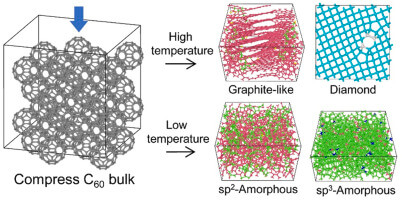
Shocking Truths About Natural Diamond Formation
Some fascinating facts about natural diamonds:
- Age: The oldest diamond over 3 billion years old, make older & most life form on Earth.
- Hardness: Diamond are 58 times harder as anything else found in nature.
- Formation Depth: Most diamond form 140 kilometers (87 miles) beneath Earth’s surface.
- Rare Colors: Naturally colored diamond, like blue, pink, and green, have incredibly rare and its hues to trace elements like boron structural anomalies.
- Industrial Use: Approximate About 80% of mined diamond are not suitable for jewelry & used in industrial application like cutting and drilling.
- Meteorite Diamonds: Some meteorite & it contain microscopic diamond,& collision in space.
- Kimberlite Rarity: Only small percentage of kimberlite pipes discover to contain diamonds, and even smaller percentage that economically viable to mine.
- Diamond Stability: It bought slowly toward surface, diamonds transform graphite to changes in temperature & pressure.
The Incredible Journey of Natural Diamonds from Earth’s Core to the Surface
The formation of natural diamond is marvel of geological processes, requiring a precise condition & billions of years. From the origins carbon deep within the Earth to the ascent through volcanic eruptions and eventual discovery, diamond are represent ultimate story of transformation and resilience.
Understanding processes not depend on diamond highlights its rarity & value. Every diamond is a fragment of Earth’s ancient history, tangible piece of a story billions of years passed in its making process. The fascinating world of diamond or explore diamond jewelry inspired by this natural wonders. drawn towards geological story & timeless beauty, diamonds are truly one of nature’s greatest achievements.
